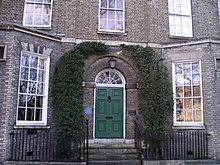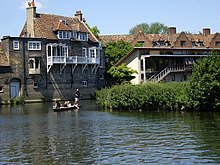Gwen Raverat
Gwen Raverat | |
|---|---|
| Born | Gwendolen Mary Darwin 26 August 1885 Cambridge,England |
| Died | 11 February 1957(aged 71) Cambridge, England |
| Resting place | TrumpingtonExtension Cemetery, Cambridge |
| Alma mater | Slade School of Fine Art |
| Occupation | Wood Engraver |
| Years active | 1911–1951 |
| Notable work | Period Piece(autobiography) |
| Spouse | |
| Children | Elisabeth (1916–2014) Sophie Jane(1919–2011) |
| Parent(s) | George Darwin Maud du Puy |
| Relatives | Darwin–Wedgwood family |
Gwendolen Mary "Gwen" Raverat(néeDarwin;26 August 1885 – 11 February 1957), was an Englishwood engraverwho was a founder member of theSociety of Wood Engravers.[1]Her memoirPeriod Piecewas published in 1952.
Biography
[edit]
Gwendolen Mary Darwin was born inCambridgein 1885; she was the daughter of astronomer SirGeorge Howard Darwinand his wife, Lady Darwin (néeMaud du Puy). She was the granddaughter of the naturalistCharles Darwinand a first cousin of poetFrances Cornford(née Darwin).[citation needed]
She married the French painterJacques Raveratin 1911. They were active in theBloomsbury GroupandRupert Brooke'sNeo-Pagan group until they moved to the south of France, where they lived inVence,nearNice,until his death frommultiple sclerosisin 1925. They had two daughters: Elisabeth (1916–2014), who married the Norwegian politicianEdvard Hambro,andSophie Jane(1919–2011), who married the Cambridge scholarM. G. M. Pryorand later Charles Gurney.[citation needed]
Raverat is buried in theTrumpingtonExtension Cemetery, Cambridge with her father. Her mother, Maud, Lady Darwin, was cremated at Cambridge Crematorium on 10 February 1947. There is a memorial to Raverat inHarltonChurch, Cambridgeshire, where her family and friends donated towards the restoration of the church in her memory.[citation needed]
Cambridge and the people associated with it remained very much the centre of her life.Darwin College, Cambridge,occupies both her childhood home, Newnham Grange, and the neighbouring Old Granary where she lived from 1946 until her death.[2]The college has named one of its student accommodation houses after her.[citation needed]
Wood engravings
[edit]Raverat was one of the first wood engravers recognised as modern. She went to theSlade Schoolin 1908,[3]but stood outside the groups growing up at the time, the group that gathered aroundEric GillatDitchlingand the group that grew up at theCentral School of Arts and CraftsaroundNoel Rooke.She was influenced by theImpressionistsandPost-Impressionistsand developed her own painterly style of engraving.[4]
There was some similarity between her early engravings and those of Gill, and she did know Gill, but the similarity was based mostly on her black line style at the time, influenced byLucien Pissarro,and the semi-religious themes that she then chose. One of her first wood engravings to appear in a book was "Lord Thomas and Fair Annet" inThe Open Window(1911), which also featured a wood engraving by Noel Rooke.[citation needed]
Balston credits her with having produced one of the first two books illustrated with modern wood engravings.[5]This wasSpring Morningby her cousin Frances Cornford, published by thePoetry Bookshopin 1915. It was accessioned at theBritish MuseumLibrary in May 1915, which makes it the first modern British book illustrated with wood engravings, as the other contender,The Devil's Devicesillustrated by Eric Gill, was accessioned in December 1915.[citation needed]
In 1922 she contributed two wood engravings toContemporary English Woodcuts,an anthology of wood engravings produced by Thomas Balston, a director atDuckworthand an enthusiast for the new style of wood engravings.Campbell Dodgson,Keeper of Prints and Drawings at the British Museum, wrote about her in his introduction to the book:Mr. Greenwood excels in the delicate and minute work in white line upon black, which has also won the admiration of many collectors for the earlier wood engravings of Mrs. Raverat.[6]Much of Raverat's work was for friends from Cambridge and appeared in books with small editions. She found a wider public with theLondon Mercurywhich reproduced many of her engravings. The most famous are perhaps the engravingsSix Rivers Round Londonwhich were produced for theLondon General Omnibus Company.[7]
Most of Raverat's commissions for book illustrations date from the 1930s. The first was for a set of engravings forKenneth Grahame'sclassic anthologyThe Cambridge Book of Poetry for Children(1932). This was published by theCambridge University Pressand printed at the press by Walter Lewis. The Cambridge University Press took almost as much care with their printing as aprivate press,and Lewis printed the wood engravings from the original blocks. He printed four more books for Raverat –Mountains and Molehillsby Frances Cornford (1934),Four Tales from Hans Andersen,a new version byR. P. Keigwin(1935),The RunawaybyElizabeth A. Hart(1936) andThe Bird TalismanbyH. A. Wedgwood(her great-uncle) (1939).Four TalesandThe Bird Talismanwere illustrated with colour wood engravings. Brooke Crutchley, Lewis's successor at the press, was responsible for printing the collection of Raverat's work byReynolds Stoneand described the care taken over printing from old warped blocks.[8]

Her experience of a real private press,St John Hornby'sAshendene Press,was rather more mixed. Raverat spent a year producing 29 wood engravings for an edition ofLes Amours de Daphne et ChloebyLongus.It appeared in 1933, five years after the project started. The first edition had been printed on Japanese vellum, but was scrapped when the ink failed to dry properly.[7]
In 1934 she produced a set of engravings forFarmer's GlorybyA. G. Street(1934), perhaps her best known work.Cottage AnglesbyNorah C. James(1935) reused engravings produced forTime and Tide.She illustratedA Sentimental JourneybyLaurence Sternefor Penguin Illustrated Classics in 1938. Her final wood engravings were for another private press, theDropmore Press,for which she illustratedLondon Bookbinders 1780–1806by E. Howe (1950).
She illustrated a number of books withline drawings,includingOver The Garden WallbyEleanor Farjeon(1933),Mustard, Pepper and SaltbyAlison Uttley(1938),Red-Letter Holidayby Virginia Pye (1940),CrossingsbyWalter de la Mare(1942),Countess KatebyCharlotte M. Yonge(1948) andThe Bedside Barsetshireby L. O. Tingay (1949).[7]
Raverat played a significant part in the wood engraving revival in Britain at the beginning of the twentieth century. By 1914 she had completed some sixty wood engravings, far more than any of her contemporaries.[4]Her name recurs consistently in all contemporary reviews, and the first book devoted to a modern wood engraver was Herbert Furst'sGwendolen Raverat.[9]She illustrated the first book illustrated with modern wood engravings,Spring Morning,and she exhibited at every annual exhibition of the Society of Wood Engravers between 1920 and 1940, exhibiting 122 engravings, more than anyone else.[4]
Raverat had to give up wood engraving after astrokein 1951.[7]
Raverat's work was part of thepainting eventin theart competitionat the1948 Summer Olympics.[10]Examples of her work were included in ‘Print and Prejudice: Women Printmakers, 1700-1930’, an exhibition at theVictoria and Albert Museumin London, 2022-23.[11]
Raverat and Cambridge
[edit]
Apart from her studies at the Slade and the period from 1915 to 1928, which covered her life with Jacques and early widowhood, Raverat lived in or near Cambridge. In 1928 she moved into the Old Rectory,Harlton,near Cambridge. The house was the model for her engravings forThe Runaway.In 1946 she moved into The Old Granary,Silver Street,in Cambridge; the house was at the end of the garden ofNewnham Grange,where she was born.[3]
Her life revolved around her contacts in Cambridge. One aspect was her work for the theatre, designing costumes, scenery and programmes. Her first experience was in 1908, when she designed costumes forMilton'sComusat the New Theatre, Cambridge. Her brother-in-lawGeoffrey Keynesasked her to provide scenery and costumes for a proposed ballet drawn fromIllustrations of the Book of Jobto commemorate the centennial of Blake's death; her second cousin,Ralph Vaughan Williams,wrote the music to the work which became known asJob, a masque for dancing,the premiere of which took place in Cambridge in 1931. The miniature stage set that she built as a model still exists, housed at theFitzwilliam Museumin Cambridge. She went on to design costumes, scenery and programmes for some ten productions, mostly for theCambridge University Musical Society.Raverat met one of her close friendsElisabeth Vellacott,in the society's production of Handel's oratorio "Jephta".[12]
Raverat had a keen interest in children's fiction. Three of her books were Victorian stories that she persuaded publishers to reprint –The Runaway,The Bird TalismanandCountess Kate.[3]When she discovered thatThe Runawayhad gone out of print, she persuaded the publisherDuckworthto reissue it in 1953.[13]
Period Piece
[edit]When she was 62 Raverat started to write her classic childhood memoirPeriod Piece,which she illustrated with line drawings. It appeared in 1952 and has not been out of print since then.[14]
Memberships
[edit]Gwen Raverat was a founding member of theSociety of Wood Engravers,which held an annual exhibition that included works from other artists such asDavid Jones,John Nash,Paul Nash,Paul GauguinandClare Leighton.[15][13]
Publications on Raverat
[edit]There are two published collections of Raverat's work. The first, by Reynolds Stone, presents many of her engravings printed from Raverat's original blocks; the second, by Joanna Selborne and Lindsay Newman, presents some 75 engravings printed from the blocks, and has long listings of Raverat's work. (The second editions of these books are not printed from the original blocks.) The catalogue of the 1989 exhibition atLancaster Universityincludes a useful bibliography.
Raverat's grandson, William Pryor, has edited and published the complete correspondence between Gwen, Jacques, andVirginia Woolf.Pryor has also blogged a talk on Raverat.
- Stone, Reynolds; Brett, Simon (1959).Wood Engravings of Gwen Raverat(1st ed.). London: Faber & Faber.(2nd ed.). Cambridge: Silent Books. 1989.ISBN9781851830084.
- Selborne, Joanna; Newman, Lindsay (1996).Gwen Raverat: Wood Engraver(1st ed.). Denby Dale, Huddersfield: Fleece Press.ISBN0948375493.(2nd ed.) London: British Library. 2003.ISBN9780712347921
- Newman, L. M.; Steel, D. A. (1989).Gwen and Jacques Raverat: Paintings & Wood-engravings: University of Lancaster Library (exhibition catalogue).Lancaster University.ISBN0-901272-64-7.
- Spalding, Frances(2001).Gwen Raverat: Friends, Family and Affections(1st ed.). London: Harvill.ISBN9781860467462.(2nd ed.). London: Pimlico. 2004.ISBN978-1844134243(a biography)
- Davidson, Rosemary, ed. (2003).Gwen Raverat: Wood Engravings of Cambridge and Surroundings.Cambridge: Broughton House.ISBN0-954391-71-3.
- Davidson, Rosemary; Pryor, Emily, eds. (2004).Gwen Raverat in France.Cambridge: Broughton House.ISBN978-0-95439-173-7.
- Pryor, William, ed. (2004).Virginia Woolf & The Raverats: A Different Sort of Friendship.Bath: Clear.ISBN1-904555-02-0.
- Davidson, Rosemary, ed. (2007).Gwen Raverat: A Miscellany.Cambridge: Broughton House.ISBN978-0-95439-176-8.
- Pryor, William (2009)."Gwen Raverat – A Neo-Pagan Darwin".williampryor.wordpress.
See also
[edit]References
[edit]- ^Joanna Selborne, ‘The Society of Wood Engravers: the early years’ inCraft History 1(1988), published by Combined Arts.
- ^Spalding, Frances (30 November 2010).Gwen Raverat: Friends, Family and Affections.Random House. p. 387.ISBN978-1-4090-2941-0.
- ^abcReynolds Stone,The Wood Engravings of Gwen Raverat(London, Faber & Faber, 1959).
- ^abcJoanna Selborne,British Wood-engraved Book Illustration 1904–1940(Oxford, Clarendon Press, 1998),ISBN0-19-817408-X.
- ^Thomas Balston,Wood-engraving in Modern English Books(London, National Book League, 1949).
- ^Campbell Dodgson,Contemporary English Woodcuts(London, Duckworth, 1922).
- ^abcdL. M. Newman and D. A. Steel,Gwen and Jacques Raverat(Lancaster, University of Lancaster, 1989);ISBN0-901272-64-7
- ^Brooke Crutchley,To be a Printer(London, Bodley Head, 1980),ISBN0-370-30304-0.
- ^Herbert Furst,Modern Woodcutters 1: Gwendolen Raverat(London, Little Art Rooms, 1920).
- ^"Gwen Raverat".Olympedia.Retrieved22 August2020.
- ^"V&A · Print and Prejudice: Women Printmakers, 1700 – 1930 - Display at South Kensington".Victoria and Albert Museum.Retrieved12 November2022.
- ^"Person."National Portrait Gallery.N.p., n.d. Web. 06 Mar. 2017.
- ^abFrances Spalding(16 November 2002)."The woodcutter's tale".The Guardian.Retrieved13 November2018.
- ^William Pryor,Virginia Woolf & the Raverats: a different sort of friendship(Bath, Clear Books, 2003),ISBN1-904555-02-0.
- ^”SWE. "SWE | Cornwall artists index.N.p., n.d. Web. 06 Mar. 2017.
External links
[edit]- Works by Gwendolyn RaveratatFaded Page(Canada)
- The Gwen Raverat Archive(raverat ) – gallery and sales, "temporarily closed" December 2022
- Guide to collection of Raverat papersat the BritishNational Archives
- Gwen RaveratatLibrary of Congress,with 21 library catalogue records
- 1885 births
- 1957 deaths
- 20th-century British printmakers
- 20th-century British women artists
- 20th-century British women writers
- 20th-century English women
- 20th-century English writers
- Alumni of the Slade School of Fine Art
- Artists from Cambridge
- British women illustrators
- Burials in Cambridgeshire
- Darwin–Wedgwood family
- English autobiographers
- English illustrators
- English women artists
- English wood engravers
- Modern printmakers
- Olympic competitors in art competitions
- British women autobiographers
- Women engravers
- 20th-century engravers
